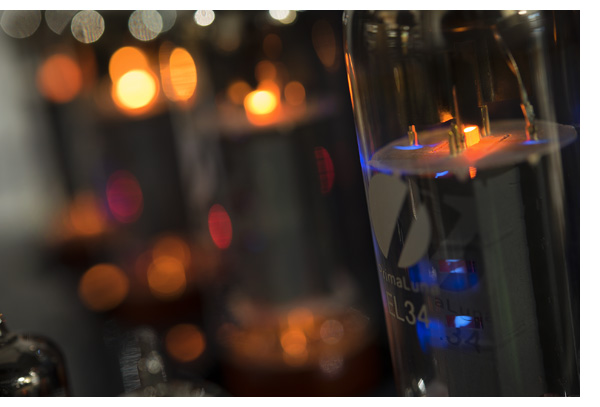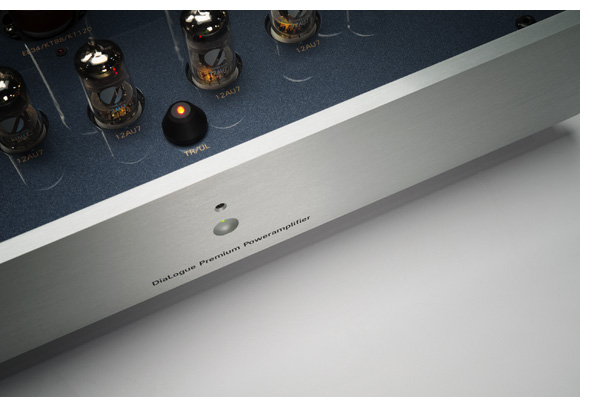 Seriously, the only thing I don’t like about PrimaLuna gear is lifting it. Recent hours at the gym notwithstanding, PrimaLuna amps keep getting heavier. Continuously improving the breed, the Dutch company keeps improving the quality of it parts, which results in bigger capacitors and beefier transformers. The DiaLogue Premium power amplifier now tips the scale just over 70 pounds. Yikes! But listening to Miles Davis’ classic album Bitches Brew float between the Focal Maestro Utopias (also reviewed in this issue), I’m not worrying about moving these amplifiers anymore. The relaxed yet resolving presentation the DiaLogue Premium amplifiers provide is sufficiently soothing to take my mind off of the manual labor.
Seriously, the only thing I don’t like about PrimaLuna gear is lifting it. Recent hours at the gym notwithstanding, PrimaLuna amps keep getting heavier. Continuously improving the breed, the Dutch company keeps improving the quality of it parts, which results in bigger capacitors and beefier transformers. The DiaLogue Premium power amplifier now tips the scale just over 70 pounds. Yikes! But listening to Miles Davis’ classic album Bitches Brew float between the Focal Maestro Utopias (also reviewed in this issue), I’m not worrying about moving these amplifiers anymore. The relaxed yet resolving presentation the DiaLogue Premium amplifiers provide is sufficiently soothing to take my mind off of the manual labor.
For those of you who are unaware, my journey as an audio writer began with PrimaLuna. My review of the ProLogue One integrated amplifier was featured in The Absolute Sound just over 10 years ago. Time flies when you’re having fun. I bought that little integrated that could, and a decade later (on only its second set of power tubes), it still can. It’s been passed on to my niece, and she’s still rocking out with it after all these years—a testament to the build quality and longevity of PrimaLuna products. Best of all, the company is building the stuff even better than when I bought that review sample, so your chances of a field failure are slim to none—a great feeling when you’re shelling out close to $10,000 for a preamplifier and a pair of monoblocks. The DiaLogue Premium amplifiers are $3,199 each, and the preamplifier will also set you back $3,199.
They’re not quite the budget components that they were in 2003, but in comparison to your favorites from ARC, CJ, McIntosh and VAC, they’re still an incredible bargain for the price asked. Those nervous about PrimaLuna being a new company back in 2003 can breathe a sigh of relief. There is now no question that the company has been making all the right moves in terms of building an empire.
The DiaLogue Premium amplifiers are especially cool, because you can start with just one and run it in stereo. Should you want or need more power, add a second amplifier, flip the stereo/mono switch on the back panel and you’re rocking. A single amplifier produces 42 watts per channel in ultralinear mode and 25 per channel in triode mode. Switching to monoblocks doubles that, making this amp a nice option for budgeting future system upgrades.
The Magic of the EL34
The enchanting midrange of that first PrimaLuna amplifier always gave me pause, thanks to the EL34 output tubes, but 30 watts per channel isn’t always enough to take care of business. Fortunately, the DiaLogure Premiums give you a choice of 82 watts per channel in ultralinear mode or 50 watts per channel in triode mode, configured as monoblocks. And there’s just something so scrumptious about using these amplifiers thusly. I suspect you may just seek out slightly more sensitive speakers so that you can always do so.
While 50 watts per channel is enough to adequately drive my 90-dB KEF Blades, the additional 3 dB of sensitivity provided by the Focal Maestro Utopias is just enough to really give the DiaLogue Premiums in mono mode that extra push over the cliff and make them that much more compelling. In the context of a system consisting of a dCS Vivaldi stack, Audio Research REF SE linestage and phonostage, along with a pair of AVID Acutus Reference SP turntables, the DiaLogues are in some pretty exclusive company. And they fit right in.
The delicate acoustic guitar at the beginning of the Verve Pipe’s “Colorful” is projected well beyond the speaker boundaries, but when the driving bass line kicks in, these amplifiers take impressive hold of the Maestros’ woofers. All this from a pair of EL34-powered monoblocks is indeed impressive.
A quick switch back to ultralinear mode delivers tighter bass, but at the expense of less midrange delicacy; the ultimate choice will be yours, but I know what I love and it’s all about the midrange with these amplifiers. Whatever your reason for going ultralinear, should you decide that is your path, go all the way and replace the EL34s with a set of KT120s. Even though the power rating is no higher, a simple flip of the switch on the right side of the amplifier resets the Adaptive Auto Bias to the correct range for this tube, eliminating potential midrange distortion. The KT120 tube has a more authoritative feel, with a deeper, tighter bass response. Overall, the amplifier has more drive and slam, feeling more like an Audio Research REF amp. Running the EL34s in triode mode makes the DiaLogue sound more like an AirTight amplifier.
Listeners who find tube amplifiers too relaxed in their presentation may think these amplifiers in triode mode are even slightly more relaxed. But this sonic characteristic works wonders when listening to recordings that are less than perfect—like my favorite records from the Monkees. “Pleasant Valley Sunday” is pretty much rubbish, but the extra sweetness that the DiaLogue Premium brings to the dance really improves recordings like this (especially in digital form), making a much larger percentage of your music collection not only listenable but enjoyable. There’s no such thing as listener fatigue with these amplifiers.
Changes Under the Hood
PrimaLuna has always paid meticulous attention to detail when building its amplifiers, which are reminiscent in quality of the great Marantz and McIntosh tube amplifiers from the 1960s. The point-to-point wiring used throughout is so neatly done that you’d swear robots did it, but this is not the case. The solder joints are all perfection and there is not a hint of untidiness anywhere. These amplifiers are as beautiful underneath their hand-finished chassis as they are above.
In addition to bigger, beefier, more robust power and output transformers, the “premium” designation comes from careful refinement of the circuit, which was executed with top-quality parts—parts you’d expect to see in amplifiers with five-figure price tags. All of the critical wiring is done with Swiss-made silver-clad oxygen-free-copper wire, the input and output connectors are first rate, and there is a plethora of premium capacitors and resistors. No corners have been cut anywhere.
And what fun would a vacuum-tube amplifier be without at least considering a bit of tube rolling? This is a bit tougher with power tubes these days, as vintage EL34s can be difficult to find, and expensive when you do find them. It’s not uncommon to spend $400 to almost $1,000 on an awesome set of NOS output tubes. Rolling in a set of Siemens and GE 6CA7s (a suitable substitution) proves sweet, eliminating grain from the presentation of the upper registers in a way that today’s modern tubes just can’t.
Fortunately, the DiaLogue Premium runs the output tubes very conservatively, and thanks to PrimaLuna’s patented Adaptive Auto Bias, adjusting tube bias is a thing of the past. The benefits are multiple: Tube life is extended, distortion is reduced, and the need for a matched quartet of output tubes is eliminated. It’s as painless as it gets for a vacuum-tube amplifier. There is even a Bad Tube Indicator, a red LED that lights up, should an output tube fail.
However, if you aren’t feeling that adventuresome but still want to get in on the action, consider swapping the small signal input tubes. Past PrimaLuna designs used at least one pair of 12AX7 tubes, which are now becoming scarcer, and consequently more expensive. A single pair of primo vintage 12AX7s can set you back $300 to $400, but this amplifier uses six 12AU7s. And these tubes are reasonable, with cool vintage examples available for $30 to $50. But remember, standard new-edition 12AU7s are only about $20 each. Either I’m getting lazy in my old age, or Kevin Deal is supplying these amplifiers with even better tubes than he was 10 years ago. In any event, I just don’t feel the need to screw around with the tubes here.
True to the PrimaLuna party line, the Adaptive Auto Bias will let you run different tube types in the various output tube sockets, but having lived with PrimaLuna amplifiers for a long time, I know that they just don’t eat tubes, so you’ll probably never need to take advantage of this feature. Sure, it does work, but if you have a tube amplifier of any kind, it’s not a bad idea to have at least a pair of output tubes of the same type on the shelf, just in case something bad does happen.
Once hefted into place and tubes installed, the DiaLogue Premium amplifiers immediately settle into reproducing music. The harp in Lloyd Cole’s “Music in a Foreign Language” floats easily behind the plane of the speakers, sounding almost like it’s in another room, well separated from Cole’s voice and acoustic guitar. Even in the 15 minutes it takes for these amplifiers to warm up, the magic is there. Unlike a few megabuck tube amplifiers we’ve used that take hundreds of hours to sound their best, we only noticed a modest change in sound character after about 50 hours. And had we not had a pair of these, so that one could run for 50 hours while the other one just sat there, we’d never know—the difference is pretty minimal. Bottom line, unbox these beauties and enjoy them.
Grab a Pair
If there’s been a better success story than PrimaLuna in the high-end audio market over the last decade, I haven’t heard it. The Dutch company continues to make top-notch products, while refining its brand and expanding its current offerings.
If you’ve ever felt intimidated by using a vacuum-tube power amplifier, PrimaLuna takes all the hassle and guesswork out of the process. The more adventurous hobbyists can tube roll to their hearts content, and the rest of you can just use the supplied tubes and dig the music.
We are happy to award the PrimaLuna DiaLogue Premium amplifier our Product of the Year award in the tube-amplifier category. A most excellent amplifier—and I suggest you get two while you are at it.
DiaLogue Premium amplifier
MSRP: $3,199 each
www.primaluna.nl (factory)
www.primaluna-usa.com (U.S. distributor)
Peripherals
| Speakers | KEF LS-50 KEF Blades Focal Maestro Utopia |
| Analog source | AVID Volvere SP turntable SME 309 tonearm Lyra Kleos cartridge |
| Digital source | OPPO 105 dCS Vivaldi stack |
| Preamplifier | PrimaLuna DiaLogue Premium Robert Koda K-10 Audio Research REF 5SE |
| Phonostage | Simaudio MOON 610LP |
| Cable | Cardas Clear |
| Power | Cardas Clear Running Springs Dmitri |

















